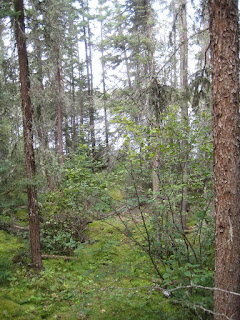The day started out with beautiful but unsettled early morning sky. This year if I waited for nice weather for travelling it would have made for little headway.
The "beaver creek" shoreline where a moose came down and ate a patch of reeds.
Because of the threatening sky, I wore my rain pants before getting in the canoe. It is not easy to don the pants while in the canoe. Then I put on my rain coat several times when it did rain.
I canoed across one km of the side of this bay looking for a portage, having to make my way through ripening wild rice. Without trying, a few handfuls of rice heads fell into the canoe, but they still were not mature enough to eat. For awhile I thought I was going to have to land and walk along the shore in the bush, but I finally spotted a possible spot that turned out to be the trail.
The winter portage was 240 metres long and needed very little clearing.
I stopped for lunch at a small point where there was a very large spruce tree. I sat under the overhanging branches of the tree well protected from the rain.
Camp 34, after travelling 17 km, including four extra km while searching for a portage and for a campsite, and two portages (60, 240 metres). While bathing in the lake one day I had an unusual experience which has great significance later on. I stepped into the lake where the bottom was deeper than expected and I went over my head in the water. When I trod on the lake bottom it was quite muddy and hundreds of large foul-smelling bubbles erupted completely over me, head and all. I swam a few metres up the lake to get out and dry off and thought nothing more of it, other than "Aie ... that's dang stinky stuff!".
Each day I was at this campsite, there was a group of about 30 common loons, with 30 gulls which continually harassed the loons, presumably to pick up some of the small fish the loons would catch.
My campsite showed obvious signs of otters, and one day a big family of eight visited me. Maybe they were going to come on shore until they saw I had invaded their space.
Lowbush cranberries ripe and ready to pick. I only saw this one group and did not pick them.
I did not know if and where there was a portage to the next big lake I wanted to reach. Thankfully I explored a long reach of shore beside the creek where I thought from the map there might be a trail. I found a winter portage to a different series of lakes than the ones I had first targeted. When I checked the creek area, I could not find a trail of any sort. If I had just checked the creek, my next plan was to canoe up the present lake several kilometres and search for a portage at another possible location, which may or may not have been successful. In that case, I then would have had to decide where I should cut a new portage.
This portage is 1300 metres long and goes through a variety of terrain - wet boggy muskeg, tall grass, young trees, mature trees - all quite pretty. Because I was not sure where on the topographical map the trail was, I used my GPS at both ends of the trail. The GPS is new this year because I have had a few occasions where I was not quite sure of my location. It proved very useful for the first time here. The worst thing I could do is assume I am heading to a target location that is not correct. It is easy in some circumstances to make the landscape "fit" the map. This trail needed a lot of clearing, taking six hours of sweaty work. Several spots required a lot of trees laid in corduroy fashion to bridge the muskeg. I only noticed one collapsed marten box but that did confirm that this was probably a trapline trail. The box was a different style than those on previous trails, so probably a different trapper's line.
Three pike caught in order of smallest to largest (15, 18, 27 inches). If I had caught the big fish first I would probably have called it enough. The three portions at the top of the cutting board constitute one fillet of the big fish. The piece at the bottom of the board contains the Y-bones which get discarded. The big fish completely filled the small one litre Ziploc™ bag, which on its own is a big meal. I did cook all the fish, but kept a meal over for lunch the next day.











































